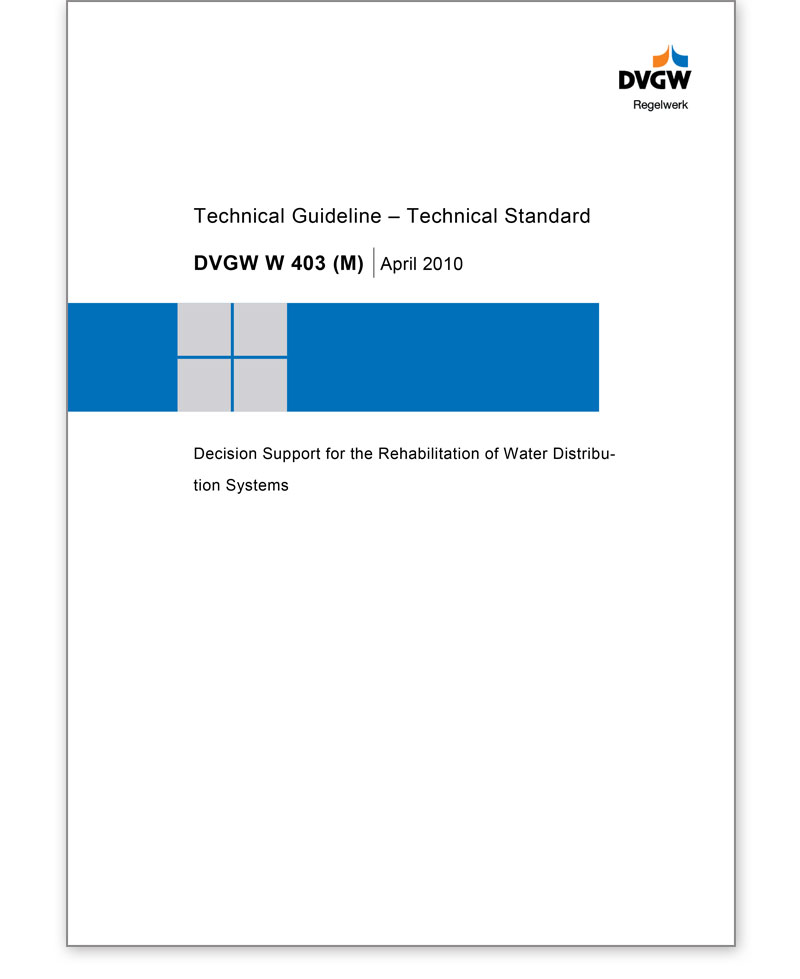W 403 Technical Guideline 04/2010
Decision Support for the Rehabilitation of Water Distribution Systems ++ PDF file ++
- Herausgeber/Verlag: DVGW
- Format: 31 pages
- Material: available as PDF only
- Ausgabe: 2nd edition 2010
- Hinweis: German version W 403
- Verkaufseinheit: 1
- Mindestabnahme: 1
- Artikel-Nr.: 509316
79,28 €*
This Guideline W 403 has been elaborated by the project group on Decision support for the rehabilitation of water pipe nets of the Technical Committee on Water distribution operation and asset management and serves as a decision support for the rehabilitation of water distribution systems. Professional circles have long used the term rehabilitation to refer to the improvement of technical infrastructures. The publication in 1997 of DVGW guideline W 401, Decision support for the rehabilitation of water pipe nets, instituted this term also into the national water supply.
The condition of water distribution systems greatly influences the adequate quantity, necessary pressure and perfect quality of the drinking water supply. System condition‑based rehabilitation (condition‑based maintenance, cf. DVGW W 400‑3 (A)) serves to meet these requirements, at the same time improving the safety of supply and economic efficiency with a focus on the holistic approach of condition‑based, riskoriented maintenance. High‑quality supply and a good system condition in accordance with the DVGW Technical Rules can be ensured only if water leakage and system failure rates as well as the risks emanating from a water distribution system or affecting it remain at low levels. Low failure rates coinciding with high water losses do not indicate high‑quality supply but rather the presence of pipe damage not yet discovered because of e.g. unfavourable soil conditions. While increased inspection activities designed to reduce water losses may be a first step towards detecting and markedly reducing local water losses, system failure rates and risks as well as water losses may be kept at permanently low levels in the long term only if the pipe system is subjected to purposeful rehabilitation work. This holistic approach of condition and risk‑based maintenance is also important in the context of international standardisation.
While the installation and development of pipeline systems is almost complete, the renaturisation and optimisation of networks has become necessary in many places in order to respond to changing societal conditions. Consequently, networks are subject not only to aging as well as wear and tear but also to adaptation processes, requiring water utilities to focus increasingly on the growing need to rehabilitate existing water distribution facilities. Rehabilitation will thus become essential in asset management, with ever more stringent requirements on the design and execution of rehabilitation.
The evolution of the Technical Rules must pay heed to this fact, as reflected by the publication of the Technical Rules on Water distribution systems (TRWV, Water Distribution Facilities, W 400 series), in particular DVGW W 400‑3 (A) and DVGW W 490 (H) published in September 2006 and January 2007, respectively, which already describe fundamental rehabilitation principles. The inclusion of sophisticated technical processes in DVGW Codes of Practise GW 320 et seq. documents state‑of‑the‑art rehabilitation solutions for technical water infrastructure. DVGW Code of Practise W 402, ?Network and failure statistics?, which will supersede DVGW W 395 (M) and is currently available as a yellow paper only, will provide an important new basis for planning rehabilitation measures.This Guideline W 403 translates the above‑mentioned statistics and analyses into actual rehabilitation activities. The fact that it has been combined with W 402 illustrates the growing future importance of highly detailed and meaningful data acquisition and maintenance processes for water utilities.As the contents of DVGW W 400‑3 (A) form the basis of this Guideline, it has been deliberately structured along the lines of DVGW W 400‑3 (A). The revised version of DVGW W 401 (H) also describes the characteristics of water distribution systems used in the long‑distance water supply.
This Guideline offers advice ‑ but no technical rules ? on how to introduce a rehabilitation strategy and elaborate rehabilitation planning. A clear distinction is being made between these afore‑mentioned activities and ongoing service activities (inspection and maintenance). The suggested method is meant to be universally applicable, regardless of the structure of a given water distribution system. Criteria shall be weighted according to the original local conditions prevailing in each case. Any empirical numeric values given are mere support values; concrete href= https://shop.wvgw.de/507926 >here. specific values. This Guideline supersedes DVGW Guideline W 401:1997‑09.
The condition of water distribution systems greatly influences the adequate quantity, necessary pressure and perfect quality of the drinking water supply. System condition‑based rehabilitation (condition‑based maintenance, cf. DVGW W 400‑3 (A)) serves to meet these requirements, at the same time improving the safety of supply and economic efficiency with a focus on the holistic approach of condition‑based, riskoriented maintenance. High‑quality supply and a good system condition in accordance with the DVGW Technical Rules can be ensured only if water leakage and system failure rates as well as the risks emanating from a water distribution system or affecting it remain at low levels. Low failure rates coinciding with high water losses do not indicate high‑quality supply but rather the presence of pipe damage not yet discovered because of e.g. unfavourable soil conditions. While increased inspection activities designed to reduce water losses may be a first step towards detecting and markedly reducing local water losses, system failure rates and risks as well as water losses may be kept at permanently low levels in the long term only if the pipe system is subjected to purposeful rehabilitation work. This holistic approach of condition and risk‑based maintenance is also important in the context of international standardisation.
While the installation and development of pipeline systems is almost complete, the renaturisation and optimisation of networks has become necessary in many places in order to respond to changing societal conditions. Consequently, networks are subject not only to aging as well as wear and tear but also to adaptation processes, requiring water utilities to focus increasingly on the growing need to rehabilitate existing water distribution facilities. Rehabilitation will thus become essential in asset management, with ever more stringent requirements on the design and execution of rehabilitation.
The evolution of the Technical Rules must pay heed to this fact, as reflected by the publication of the Technical Rules on Water distribution systems (TRWV, Water Distribution Facilities, W 400 series), in particular DVGW W 400‑3 (A) and DVGW W 490 (H) published in September 2006 and January 2007, respectively, which already describe fundamental rehabilitation principles. The inclusion of sophisticated technical processes in DVGW Codes of Practise GW 320 et seq. documents state‑of‑the‑art rehabilitation solutions for technical water infrastructure. DVGW Code of Practise W 402, ?Network and failure statistics?, which will supersede DVGW W 395 (M) and is currently available as a yellow paper only, will provide an important new basis for planning rehabilitation measures.This Guideline W 403 translates the above‑mentioned statistics and analyses into actual rehabilitation activities. The fact that it has been combined with W 402 illustrates the growing future importance of highly detailed and meaningful data acquisition and maintenance processes for water utilities.As the contents of DVGW W 400‑3 (A) form the basis of this Guideline, it has been deliberately structured along the lines of DVGW W 400‑3 (A). The revised version of DVGW W 401 (H) also describes the characteristics of water distribution systems used in the long‑distance water supply.
This Guideline offers advice ‑ but no technical rules ? on how to introduce a rehabilitation strategy and elaborate rehabilitation planning. A clear distinction is being made between these afore‑mentioned activities and ongoing service activities (inspection and maintenance). The suggested method is meant to be universally applicable, regardless of the structure of a given water distribution system. Criteria shall be weighted according to the original local conditions prevailing in each case. Any empirical numeric values given are mere support values; concrete href= https://shop.wvgw.de/507926 >here. specific values. This Guideline supersedes DVGW Guideline W 401:1997‑09.
Foreword
1 Scope
2 Normative references
3 Terms, symbols, units and abbreviations
3.1 General reference
3.2 Rehabilitation rate
3.3 Risk
4 Fundamentals and objectives
4.1 General
4.2 Distinguishing between rehabilitation strategies, rehabilitation planning and rehabilitation measures
5 Rehabilitation strategy
5.1 Fundamentals
5.2 Service life and failure development
5.3 Determining the need for rehabilitation
5.3.1 General
5.3.2 Method 1: Direct asset group-specific derivation from service life
5.3.3 Method 2: Derivation from technical service lives and age-related existing asset lengths
5.3.4 Method 3: Derivation from mathematical distribution functions
5.3.5 Examining the consequences of miscalculation
5.4 Development and comparison of alternative rehabilitation strategies
5.5 Adjustment of rehabilitation strategies with strategic network optimisation
5.6 Budgeting
6 Rehabilitations planning (medium-term planning)
6.1 Network evaluation systematics
6.2 Individual evaluation and prioritising
6.3 Coordination with other construction activities
6.4 Budgeting
7 Rehabilitation measures
8 Documentation and efficiency review
Annex A (informative) ? Examples illustrating how to determine the need for rehabilitation, depending on data availability
A.1 Data availability and methodology
A.2 Method 1: Direct asset group-specific derivation from service life in accordance with 5.3.2
A.3 Method 2: Derivation from service life and age-related existing asset length in accordance with 5.3.3
A.4 Method 3: Derivation from mathematical distribution functions in accordance with 5.3.4
A.5 Comparison of rehabilitation rates determined by methods 1 through 3
Annex B (informative) ? Example comparing two alternative rehabilitation strategies
1 Scope
2 Normative references
3 Terms, symbols, units and abbreviations
3.1 General reference
3.2 Rehabilitation rate
3.3 Risk
4 Fundamentals and objectives
4.1 General
4.2 Distinguishing between rehabilitation strategies, rehabilitation planning and rehabilitation measures
5 Rehabilitation strategy
5.1 Fundamentals
5.2 Service life and failure development
5.3 Determining the need for rehabilitation
5.3.1 General
5.3.2 Method 1: Direct asset group-specific derivation from service life
5.3.3 Method 2: Derivation from technical service lives and age-related existing asset lengths
5.3.4 Method 3: Derivation from mathematical distribution functions
5.3.5 Examining the consequences of miscalculation
5.4 Development and comparison of alternative rehabilitation strategies
5.5 Adjustment of rehabilitation strategies with strategic network optimisation
5.6 Budgeting
6 Rehabilitations planning (medium-term planning)
6.1 Network evaluation systematics
6.2 Individual evaluation and prioritising
6.3 Coordination with other construction activities
6.4 Budgeting
7 Rehabilitation measures
8 Documentation and efficiency review
Annex A (informative) ? Examples illustrating how to determine the need for rehabilitation, depending on data availability
A.1 Data availability and methodology
A.2 Method 1: Direct asset group-specific derivation from service life in accordance with 5.3.2
A.3 Method 2: Derivation from service life and age-related existing asset length in accordance with 5.3.3
A.4 Method 3: Derivation from mathematical distribution functions in accordance with 5.3.4
A.5 Comparison of rehabilitation rates determined by methods 1 through 3
Annex B (informative) ? Example comparing two alternative rehabilitation strategies

